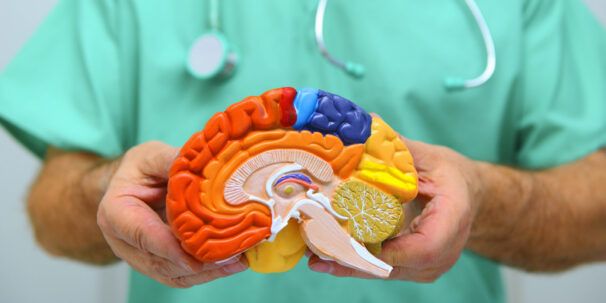Five online courses to improve your brain health
Brain health is essential to a functional and fulfilling life. We look at five great courses that explore the topic and teach you how to support the health of your brain.

Brain health is hugely important. Your brain is the most complex and energy-intensive organ in your body. It’s home to around 100 billion neurons (about the same as the number of stars in the galaxy) and billions more glial cells. Despite making up just 2% of your body by mass, it will consume around 20% of your body’s energy – which makes it the largest brain per body mass of any mammal.
It’s in the brain that we do just about everything that involves thinking. It’s responsible for generating our daily thoughts and feelings, dealing with problem-solving, telling the rest of our body what to do, and giving us our sense of who we are.
Given the importance of your brain, it’s only sensible that you take the time to keep it in good condition. Brain health can have a sizeable effect on your daily life. Develop the right brain habits and you can drastically improve your quality of life.
What is brain health?
Health is commonly defined as the absence of disease and infirmity. But this is something that’s explicitly rejected by the World Health Organisation. When they seek to determine who’s healthy and who isn’t, they look at complete social, mental and physical wellbeing. After all, health should be a measure not only of the problems you have now, but the ones that you’re likely to develop in the future.
Why is brain health important?
This isn’t the first time we’ve written about brain health and why it matters. You use your brain for just about everything you do in life. This includes the things that you consciously deliberate over but also applies to your unthinking reactions to the world around you. If you feel a certain way when you’re presented with a certain set of stimuli (like hunger when you smell food cooking), then that’s processed and generated by your brain.
Read our blog about the various parts of the brain and what they do, to learn more. We still have a long way to go to understand our brains completely. What we do know is that for your brain to work properly, it needs to be supported in multiple ways.
How to keep your brain healthy
Brain health can be bolstered through a range of different methods. Let’s look at just a few of them before we move on to our selection of the best online courses to improve brain health.
Brain health and nutrition
The foods we eat play a critical role in supporting the growth and function of a healthy brain. Certain nutrients, like the fatty acids found in oily fish, are strongly linked to cognitive improvements. Include them in your diet and you’ll be less likely to develop neurological disorders like Alzheimer’s and Dementia.
Mindfulness and meditation
Mindfulness is a kind of meditative practice that has become popular over recent years. To be mindful is to be aware of what’s going on around you, both internally and externally. An easy way to practise mindfulness is by taking a moment to focus on your breathing.
Meditation is a practice that uses a technique (like mindfulness) to clear the mind and connect with yourself and your surroundings. Learn more about meditation in this open step, Introduction to Meditation. Follow on with Practicing Mindfulness: A Guided Meditation by the University of Michigan.
Brain health and exercise
Healthy body, healthy mind. It’s not just a well-worn piece of folk wisdom: there’s a mountain of evidence to suggest that exercise is good for your brain. Exercise releases feel-good hormones, provides a distraction from stress, and helps you sleep better. This video open step, Exercise for Brain Health, provides a complete overview of the subject.




Brain health and sleep
Your brain has adapted to repair itself at night-time during sleep. Sleep is not a well-understood phenomenon, but we do know that it comes in multiple stages. Each of these stages is essential to the continued function of the brain. Chronic sleep deprivation is something that can create mental and physical health issues. If you’re working irregular hours, then you’re more susceptible.
Mental health and brain health
You might think of brain health as synonymous with mental health in general. Often, when we talk about brain health, we’re focusing more on the physical organ (or hardware) itself, rather than the software that’s loaded into it. However, good mental health is equally as important as brain health. They can both impact one another, and being aware of this connection is important to address the improvement of both.
If you’re struggling with your mental health in general, or you’d like to take a preventative approach, then you might look into our blog on tips to support your mental health, too.
5 courses to learn about and increase your brain health
FutureLearn offers a range of courses designed to bolster your brain health. Let’s take a look at five in particular.
1. Sport and Exercise for Brain Health by Brain Health Scotland
This two-week course provides an overview of the latest science behind brain health. It’s CPD-certified and supported by Alzheimer Scotland, so you can be sure that it conforms to the highest professional standards.
Athletes can face a series of direct challenges to their brain health, which require mediating strategies. This is explored in the course, along with the concept of a ‘brain health pension’: the things you do throughout your life that will support you as you go into old age.
Get a look at the sharp end of brain health research, used by high-end athletes and sports scientists. There’s even a cameo from a former Olympian in the course. Professors from several different universities, including Edinburgh, Dublin, and Glasgow University, lead the course to give a thorough insight into this fascinating topic.
2. Understanding Brain Health: Preventing Dementia by Brain Health Scotland and the University of Edinburgh
This course has a particular focus on one brain disease: dementia. It’s something that fifty million people around the world are living with and this figure is set to rise dramatically over the coming decades, to around 150 million by 2050.
Most of these diagnoses occur in the latter stages of the disease, so it’s important to do whatever we can to lower the risk. This course explores exactly what the risk factors might be, not only for dementia but for other diseases, too. It also explores how the discoveries made by brain researchers can be applied to clinical services.
If you’re interested in learning how to keep your brain sharp, check out this open step from the Strategies for Successful Ageing course.
Brain research is a complicated subject, and if you aren’t subscribed to specialised journals, then it can be difficult to stay on top of new developments. That’s why this course is worth taking, as an insightful and eye-opening look into the topic and coverage of brain research.
3. The Science of Sleep and Dreams by New Scientist
Sleeping and dreaming are among the most interesting and mysterious phenomena in the body. Although we all dream, the exact functions dreams perform aren’t all that well-understood.
In this course, from the New Scientist Academy, you’ll learn about all the benefits of the various stages of sleep. You’ll get a tour through all of the various sleep theories and the evidence that supports them, as well as practical advice on how to sleep better.
Sleep deprivation has profound effects on brain health. It can cause drowsiness and fatigue and inhibit our ability to focus. In the long term, it’s highly correlated with dementia and with a worse prognosis for those already suffering from brain disorders. Anything we can do to improve our sleeping habits is therefore going to be good news for our brains!
4. Food for Thought: The Relationship Between Food, Gut and Brain by EIT Food and the University of Torino
Your brain needs the right fuel if it’s going to grow and prosper. Certain foods have a proven link to good brain health – and knowing what they are and how to incorporate them into your diet is invaluable.
In this course, you’ll learn how certain deficiencies are associated with certain brain disorders, and how the right diet can support your microbiome, as well as your health more broadly.
You might also look at Deakin University’s course on Food and Mood, and in particular the open step on the importance of diet for mental and brain health.
5. Music Psychology: Why Does “Bohemian Rhapsody” Feel So Good? By Griffith University
Music is something that can speak to us in amazing ways. When the right chords are thrown together, creating an earworm vocal melody or a sizzling string arrangement, the response it elicits is undeniable. Music can inspire deep, raw emotion, or feelings of awe. The effect can be almost magical.
Exactly why certain pieces of music work their magic, and how they do it, is a question that brings together art and science. This course looks at this question from a music psychology perspective. It’ll explore psychological fundamentals, like the nature and purpose of emotions, and how music can tap into them.
It does this by taking a deep dive into one of the most well-known and popular pieces of music ever released: Bohemian Rhapsody, by Queen. Great music can stir up emotional memories, maintain speech and language function, and help to dissipate anxiety. By understanding music better, you’ll get more out of it – and so will your brain!
Start improving your brain health today
Developing good brain health habits is important for ensuring you live a long, healthy life with a sharp brain. At FutureLearn, we offer a wide variety of courses covering brain health from multiple angles. If you’d like to learn about what your brain is doing and what you can do to make it work better, then the chances are there’s a course for you.






